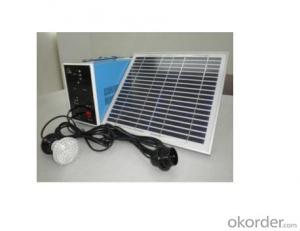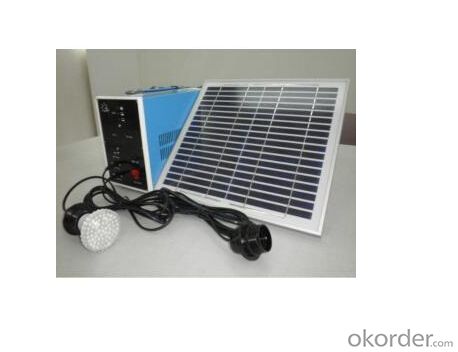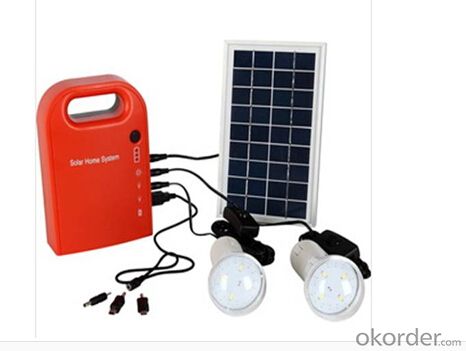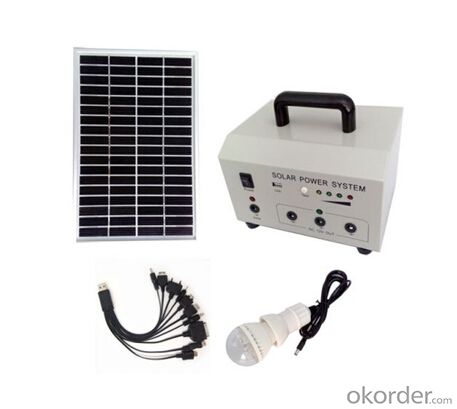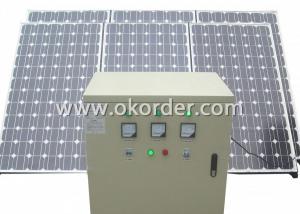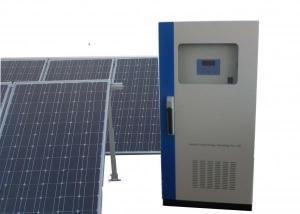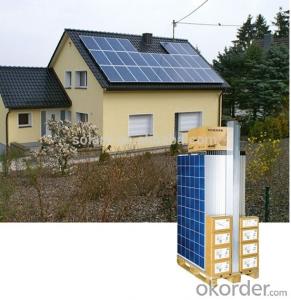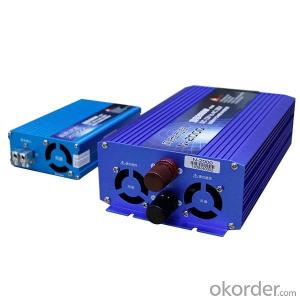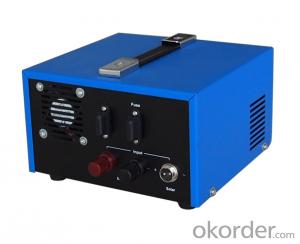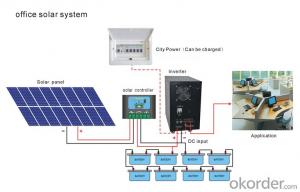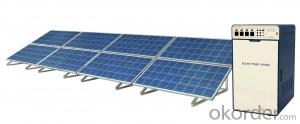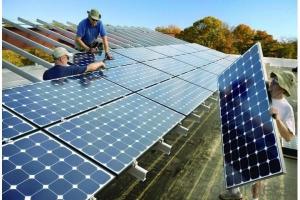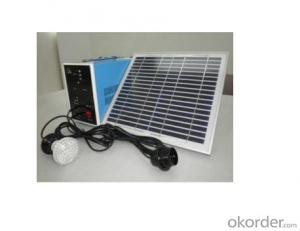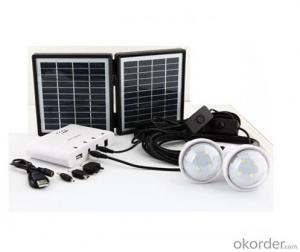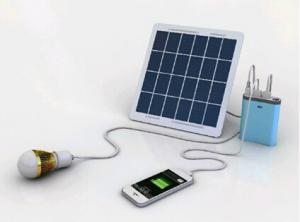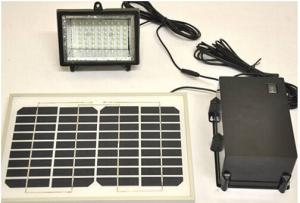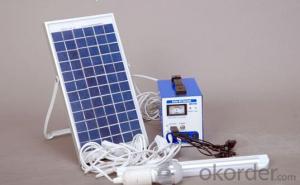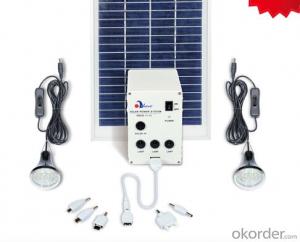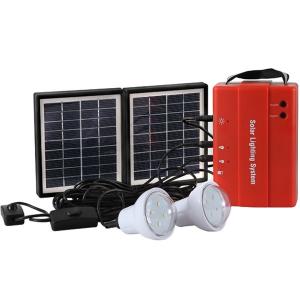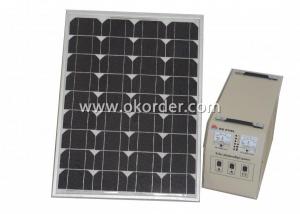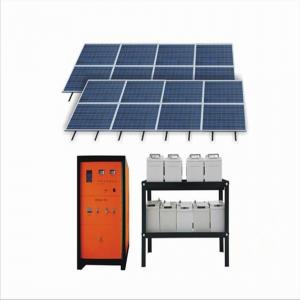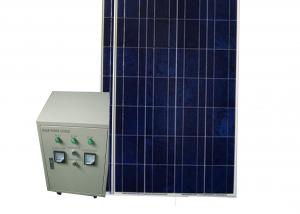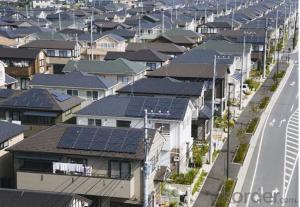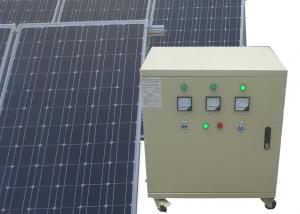Sun Vision Solar Energy Systems - CNBM Solar Home System Roof System Capacity-15w
- Loading Port:
- Shanghai
- Payment Terms:
- TT or LC
- Min Order Qty:
- 5 unit
- Supply Capability:
- 30000 unit/month
OKorder Service Pledge
OKorder Financial Service
You Might Also Like
Introduction of Solar Home System
Solar Home System is quite suitable product in urban area and the place which is short of electricity. Our Small Solar Home System own great benifits compare with other kind electricity resources:
Electricity generating cost of Solar Home System is much cheaper than diesel engine. Beside low electricity making cost, solar system products also have the features of noiseless, clean energy, environmentally friendly and can access to many different electric appliance.
Working Principle of Solar Home System
The stand alone Solar Home System is an off-grid solar system which uses batteries to store the solar energy. Stand alone solar system solutions design for those who are not able or willing to connect to electricity grid.
However, our on-grid solar home system can be connected to the grid for utilization of grid electricity power. Our solar system can add relative equipment as our customer’s requirement which have the function of switching to city electricity automatically. The solar system can use battery power in priority, if sunshine is not so good or loads consumption is too high which cause battery power insufficient. Then system can switch automatically to grid power supply. Meanwhile, the system can charge the batteries with grid power until batteries are fully charged. Then the solar system will switch back to battery power supply.
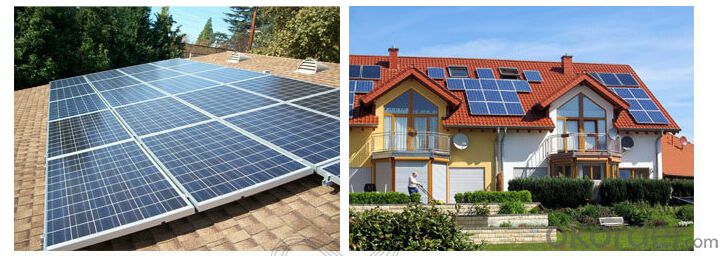


Specification of Solar Home System
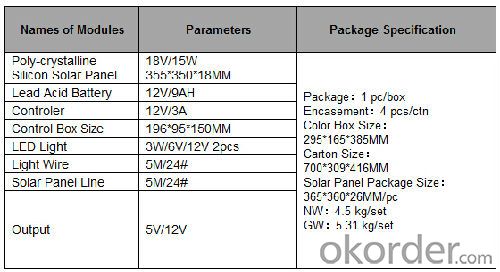
Advantage of Our Solar Home System
1 Excellent Performance: Our Solar Home System is composed by Brand Standard Kits with high quality. Our solar system has the advantage of high efficiency and stable operation. We can ensure our product with a long life period.
2. Small Orders Accepted: We can accept small orders as our customer’s trial order.
3. Warehouse: We have warehouse overseas which can bring great convenience to our customer to pick up the products.
FAQ
Q: Could you introduce the background of your company?
A: We are a Group corp. with 1GW capacity in China, which is Okorder’s registered VIP Supplier, possess Financial Service from Okorder.com.
Q: Required mainly certificates (CE&IEC/TUV/RoHS)?
A: Our products are certificated by CE RoHS, IEC, ISO, TUV, UL etc.
Q: Your main exported market is?
A: Main markets of our products is: South-east Asia, Mid-east, Arica, East Europe and Latin America.
- Q: Can solar energy systems be used for powering sports stadiums?
- Yes, solar energy systems can definitely be used for powering sports stadiums. With their large open spaces and high electricity needs, sports stadiums are ideal candidates for solar installations. Solar panels can be installed on the stadium roof or in nearby open areas to capture sunlight and convert it into electricity. This renewable energy source can help stadiums reduce their reliance on traditional power grids, lower their carbon footprint, and potentially even generate excess energy that can be fed back into the grid.
- Q: Can a solar energy system be installed in an area with high wind speeds?
- Yes, a solar energy system can be installed in an area with high wind speeds. However, it is essential to consider the wind load requirements and design the system accordingly to ensure its stability and durability in such conditions. This may involve using specialized mounting systems, robust materials, and proper anchoring methods to withstand the impact of strong winds and prevent any damage to the system.
- Q: How does the quality of solar panels vary across different manufacturers?
- The quality of solar panels can vary greatly depending on the manufacturer chosen. Numerous factors contribute to this variation. To begin with, the materials utilized during the manufacturing process have a significant impact on panel quality. Some manufacturers may opt for cheaper materials that degrade over time or have lower efficiency, while others may choose high-quality materials that ensure durability and optimal performance. The type and quality of photovoltaic cells used in the panels can also differ, affecting their conversion efficiency and overall power output. Furthermore, the manufacturing processes and technologies employed by different manufacturers can influence the quality of solar panels. Companies that invest in advanced production techniques and implement stringent quality control measures are more likely to produce panels with superior workmanship and reliability. Conversely, manufacturers with inadequate manufacturing processes may produce panels that are more prone to defects, malfunctions, or premature degradation. The level of research and development undertaken by manufacturers also plays a significant role in panel quality. Companies that invest in research and development are often at the forefront of technological advancements, resulting in panels with higher efficiency, better durability, and improved performance. In contrast, manufacturers that lack investment in R&D may offer panels with outdated technology or lower reliability. Additionally, the reputation and track record of a manufacturer can provide valuable insights into the quality of their solar panels. Established manufacturers with a long history of producing reliable and high-performance panels are generally more trustworthy than new or unfamiliar companies. Independent certifications and third-party testing can also help assess the quality of panels, as they provide an unbiased evaluation of their performance, durability, and adherence to industry standards. Consumers should conduct thorough research and comparisons among different manufacturers before investing in solar panels. Factors such as materials, manufacturing processes, research and development investments, reputation, and certifications should all be taken into consideration to determine the quality and long-term reliability of the panels.
- Q: Do solar energy systems require a battery for storage?
- No, solar energy systems do not necessarily require a battery for storage. While batteries can be used to store excess solar energy for later use, it is not a mandatory component of a solar energy system.
- Q: Can solar energy systems be used in areas with limited access to sunlight due to shading from nearby buildings or structures?
- Solar energy systems can still be used in areas with limited access to sunlight due to shading from nearby buildings or structures, but their efficiency may be reduced. It is important to design and position the solar panels properly to maximize exposure to sunlight throughout the day. Additionally, advanced technologies like solar tracking systems or micro-inverters can help mitigate the impact of shading, making solar energy viable even in shaded areas.
- Q: Can solar energy systems be used for powering outdoor recreational activities?
- Yes, solar energy systems can indeed be used to power outdoor recreational activities. They can provide a sustainable and renewable source of power for various activities such as camping, hiking, and boating. Solar panels can be used to charge portable batteries or directly power devices like lights, fans, radios, and even small appliances. This allows outdoor enthusiasts to enjoy their activities while minimizing their environmental impact and reducing reliance on traditional energy sources.
- Q: How does the tilt of solar panels affect their performance?
- The tilt of solar panels plays a significant role in determining their performance and overall efficiency. The optimal tilt angle for solar panels depends on various factors such as geographical location, season, and application. The primary reason why the tilt angle is crucial is to maximize the amount of sunlight that the solar panels can capture. Solar panels work by converting sunlight into electricity, and the angle at which they are tilted affects the amount of sunlight they receive. In general, solar panels generate the most electricity when they are perpendicular to the sun's rays. This means that during the peak hours of sunlight, panels tilted at an optimal angle will receive the maximum solar radiation. If the angle is too steep or too shallow, the amount of sunlight that the panels can capture decreases, thus reducing their performance. The optimal tilt angle also varies depending on the season. In summer, when the sun is higher in the sky, a steeper tilt angle may be more suitable to capture maximum sunlight. In contrast, during winter, a shallower tilt angle can help ensure that the panels receive sunlight even with lower sun angles. Geographical location is another crucial factor that influences the tilt angle of solar panels. The closer a location is to the equator, the less variation there is in the sun's angle throughout the year. Therefore, the optimal tilt angle for solar panels may be closer to the latitude of the location. For example, in equatorial regions, solar panels are often mounted nearly flat to maximize their exposure to the sun's rays. In addition to maximizing sunlight exposure, the tilt angle also affects the self-cleaning capability of solar panels. Rainfall can help wash away dirt and debris from the panel's surface, preventing the buildup of grime that can reduce their efficiency. A proper tilt angle can facilitate the natural cleaning process by allowing rainwater to flow down the surface more effectively. In summary, the tilt angle of solar panels directly affects their performance. With the right tilt angle, solar panels can capture the maximum amount of sunlight, leading to higher electricity generation. Considering the geographical location, season, and desired performance, it is crucial to determine an optimal tilt angle to maximize the efficiency and overall output of solar panels.
- Q: Can solar energy systems be used for heating and cooling homes?
- Solar energy systems have the potential to be utilized for both heating and cooling homes. The energy from the sun can be captured by solar panels or solar water heaters to generate electricity or heat, which can then be used to power heating and cooling systems within homes. For heating purposes, there are various methods in which solar energy can be employed. Solar thermal systems can be installed to warm water for radiant floor heating or produce steam for heating purposes. Solar air heating systems are another option, as they can warm the air that can be distributed throughout the house using ductwork and fans. Additionally, solar heat pumps can be utilized to transfer heat from the sun into the home. In a similar vein, solar energy can also be effectively utilized for cooling homes. Solar-powered air conditioning systems can be employed, utilizing solar energy to operate the compressors and fans necessary for cooling. These systems are particularly advantageous in regions with hot climates, where sunlight availability aligns with the need for cooling. The use of solar energy systems for both heating and cooling offers numerous benefits. First and foremost, solar energy is a clean and renewable source of energy, which reduces reliance on fossil fuels and minimizes carbon emissions. Furthermore, the use of solar energy systems provides long-term cost savings, as they decrease or eliminate the need for traditional heating and cooling methods that rely on grid electricity or fossil fuels. Additionally, solar energy systems can be easily integrated into existing homes or included in new construction projects, making them a versatile and sustainable option for heating and cooling residential properties.
- Q: Are solar energy systems noisy?
- No, solar energy systems are generally quiet as they do not involve moving parts or combustion processes.
- Q: What are the different financing options for solar energy systems?
- There are several financing options available for solar energy systems, including cash purchases, solar loans, solar leases, power purchase agreements (PPAs), and property assessed clean energy (PACE) financing. Cash purchases involve paying the full cost of the system upfront. Solar loans allow homeowners to borrow money to finance the system and pay it back over time with interest. Solar leases involve leasing the system from a third-party provider and paying a fixed monthly fee. PPAs allow homeowners to purchase the electricity generated by the system at a predetermined rate. PACE financing allows homeowners to finance the system through an additional assessment on their property taxes.
Send your message to us
Sun Vision Solar Energy Systems - CNBM Solar Home System Roof System Capacity-15w
- Loading Port:
- Shanghai
- Payment Terms:
- TT or LC
- Min Order Qty:
- 5 unit
- Supply Capability:
- 30000 unit/month
OKorder Service Pledge
OKorder Financial Service
Similar products
Hot products
Hot Searches
Related keywords
